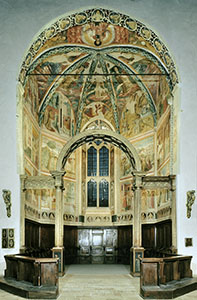
Chapel of the Choir, Church of St. Francis, Montefalco.
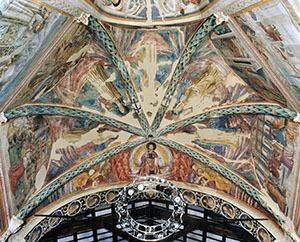
Saint Francis and Five Saints from the Franciscan Order in Glory with Angels, vault of the Chapel of the Choir, Church of St. Francis, Montefalco.
The main chapel of the Franciscan Church in Montefalco was built between 1336 and 1340 and frescoed by Benozzo Gozzoli between 1450 and 1452. The cycle of frescoes depicts the most important episodes from the life of Saint Francis, founder of the famous monastic order, according to a programme perhaps set out by the man who commissioned it, Fra Jacopo di Mattiolo. Critics have identified the primary source of the narration as the De Conformitate Vitae Sancti Francisci ad Vitam Domini Jesu (On the Conformity of the Life of Saint Francis to the Life of Our Lord Jesus Christ), a text written between 1385 and 1390 by the learned Fra Bartholomew of Pisa.
The stories are narrated on the walls divided into sections by six small pillars that join the ribs of the vault. The order of the twelve sections (making a total of 19 episodes), set out in three registers, runs from left to right and from the bottom up. The cycle concludes on the vault with an image of Saint Francis and five saints from the Franciscan Order sitting on high among the angels. The Saint appears once again on the intrados, portrayed in the act of showing his stigmata, surrounded by his twelve closest companions.
The episodes are deliberately not narrated in chronological order. This is a deliberate descriptive method, officially authorised by Saint Bonaventure (Saint Francis’ official biographer) who favoured a thematic approach to the events in the earthly life of this tormented man.
The cycle focused on the life of Saint Francis, with particular emphasis on the similarities between the way he lived his life and the life of Jesus Christ. In order to make these ancient stories more comprehensible to his contemporaries, Benozzo modernised them by setting them in more "up-to-date" surroundings consisting of architecture and landscapes from his own time. The painter employed this device throughout his work, for example in the Magi Chapel in Florence, the Church of St. Augustine in San Gimignano and the Tabernacle in Castelfiorentino.
Montefalco’s close proximity to the city of Assisi and the quintessential Franciscan building did not prevent this cycle from differing considerably, in terms of format and the episodes depicted, from the Stories of Saint Francis frescoed by Giotto in the Basilica Maggiore, to which artists traditionally tended to refer.
Indeed, in the Basilica of St. Francis in Assisi, Giotto painted the twenty-four scenes on a single wall and in a single register. Benozzo, on the other hand, painted the stories on three levels, seeking to adapt the paintings to the pre-existing (tall and narrow) structure of the apse, often by depicting several events in one section. The other distinctive aspect of the cycle in Montefalco is the iconography, in which the miracles that occurred after the Saint’s death are excluded whereas, in the iconography used in Assisi, these miracles assume greater importance than the wondrous events from his life.
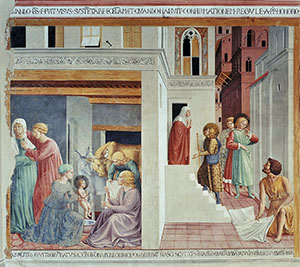
The Birth of Saint Francis, the Prophecy of the Pilgrim and the Homage of the Simple Man, Church of St. Francis, Montefalco.
Panel I
The first scene illustrates three events from the life of Saint Francis: on the left, the Birth of Saint Francis, in the centre, the Prophecy of the Birth by a Pilgrim and, on the right, the Homage of the simple man. The birth episode is set in a simple dwelling. The newborn Francis is surrounded by onlookers and an ox and a donkey (animals which were also present at the birth of the Baby Jesus).
Outside the building, Benozzo illustrated two separate events, one before and one after the above-mentioned episode. In the first, a pilgrim comes to the steps of his mother’s house and prophesises the birth of Francis. This character, recognisable by his halo, represents Christ, and the episode is comparable to the Archangel telling Mary of her conception. To the right, along the street, the young Francis can be seen accompanied by a boy and, in the foreground, a kneeling beggar offers him his cloak.
The episode of the birth of the Saint is rather curious. Indeed, it was not usual to depict this moment (also absent from Giotto’s famous cycle in Assisi) since the event was not mentioned in the official biographies.
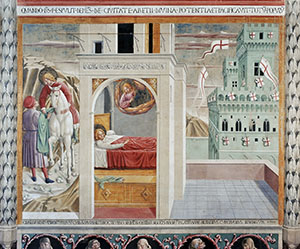
The Dream of the Palace, Church of St. Francis, Montefalco.
Panel II
The second fresco illustrates two episodes from the Saint’s youth. On the right, Francis is depicted in the act of giving his cloak to a noble but poor horseman. In the centre, the Dream of the Palace is depicted, in which Francis dreams of seeing a great and magnificent palace flying warlike banners bearing the sign of the cross and, when he asks to whom they belong, a heavenly voice answers that they will belong to him and his disciples.
The story once continued in the lost stained glass window (as we know from a surviving inscription) with Saint Damian’s Vision according to which the Saint, praying before the Crucifix, heard the voice of God no less than three times, repeating "Go, o Francis. Repair my house which is falling into ruin".
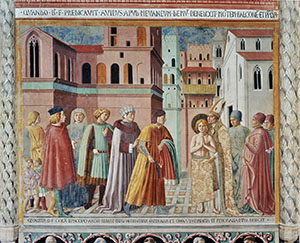
The Renunciation of Worldly Goods, Church of St Francis, Montefalco.
Panel III
The episode depicted here is the Renunciation of Worldly Goods, in other words the moment when Francis decides to return his belongings to his father. The story is set amid complex architectural structures, with particular emphasis on the use of space and careful light effects. The focal point of this highly dramatic scene is Francis’ father, who intervenes, with an extraordinarily expressive face, while Francis takes off his clothes in a sign of his renunciation of all unnecessary property. The Bishop of Assisi, Guido II, covers the young man’s nudity with his own stole, richly decorated by Benozzo.
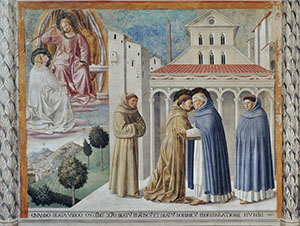
The Meeting of Saint Francis and Saint Dominic, Church of St. Francis, Montefalco.
Panel IV
The final scene in the lower register illustrates the Meeting of Saint Francis and Saint Dominic, an episode from the life of Saint Dominic recounted in the Golden Legend. Christ is about to hurl three spears (symbolising lust, greed and pride) at the sinful world, but Mary intercedes, pointing out the meeting between these two Saints who founded two important mendicant orders. This event, legend has it, took place in Rome in 1215 in front of the house of the Lord. The holy city is evocatively represented by Benozzo through an obelisk painted to the left of the church.
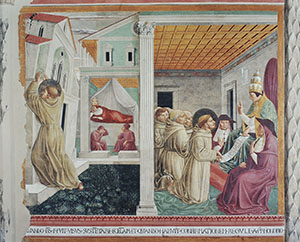
The Dream of Innocent III and the Confirmation of the Rule, Church of St. Francis, Montefalco.
Panel V
The story then continues on the left-hand wall in the second register, immediately above the Birth of Saint Francis. Two episodes are illustrated in this panel: the Dream of Innocent III and the Confirmation of the Rule. The first episode depicts Pope Innocent III who had a vision of the Lateran Basilica collapsing and poor Francis toiling to hold it up. This "premonition" is a consequence of the story narrated on the right-hand side in a beautiful scene featuring Pope Honorius III (Pope Innocent’s successor) who approved the Rule of the Franciscan Friars in 1223 in his Bull, Solet annuere. This event is often mistakenly attributed to Innocent III, who did not officially approve the Rule but gave his consent to its "testing".
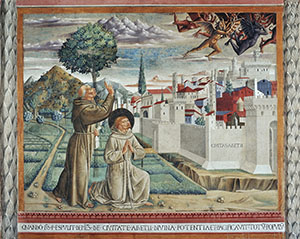
The Expulsion of the Devils from Arezzo, Church of St. Francis, Montefalco.
Panel VI
This scene depicts the Expulsion of the Devils from Arezzo. The town of Arezzo is identifiable not only by the writing on its walls but also by the accurate view of the buildings which Benozzo painted as they stood in his day in order to visually aid viewers in recognising the location.
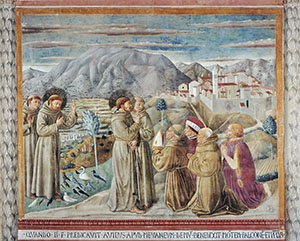
Preaching to the Birds and the Blessing of Montefalco, Church of St. Francis, Montefalco.
Panel VII
The next episodes - Preaching to the Birds and the Blessing of Montefalco - are set in a real landscape depicted in minute detail. On the left, at the foot of the mountain, is Assisi with its castle and the imposing Convent Church of St. Francis, built only after the Saint’s death. Francis speaks to the birds (thirteen different species of which are portrayed here) while pointing to the sky to indicate that he is inspired in this act by God the Father. On the right-hand side of the panel, Montefalco, encircled by its town walls, forms the backdrop to the figures in the foreground.
Francis, accompanied by his disciple, blesses four praying men, one of whom is recognisable as the Franciscan friar Jacopo (who commissioned the work) and, presumably, two members of the Calvi family who made several significant donations to the Church of St. Francis in Montefalco in the fifteenth century. This blessing is a reference to a local tradition and is not mentioned in any stories from the life of Saint Francis.
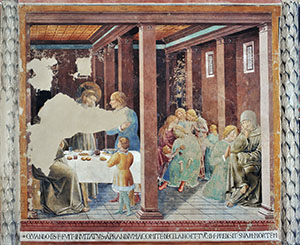
Saint Francis with the Knight of Celano, Church of St. Francis, Montefalco.
Panel VIII
This fresco shows the interior of a typical Renaissance house, with a coffered ceiling and a tile-covered floor. A hallway, marked out by pillars, divides the room into two parts. The left-hand side, where there are many gaps in the fresco, narrates the lunch of Francis with the Knight of Celano. Legend has it that, during this meeting, the Saint predicted the nobleman’s death. The story continues on the right-hand side, in chronological order, with the Knight, after Francis’ announcement, resolving to atone for his sins. This is followed, in the background, by his sudden death.
The cycle continues in the third register in which the scenes are framed by the five lunettes (one above each wall including the central wall occupied by the great window). In this upper section, Benozzo depicts one event at a time, with one significant exception, namely the episode of the Stigmatisation of Saint Francis, which occupies two lunettes. The artist undoubtedly wished to underline, in this way, the importance of Francis, the only saint to receive the stigmata, the marks of Jesus.
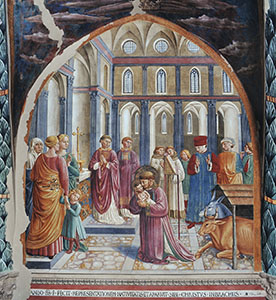
The Nativity Scene in Greccio, Church of St. Francis, Montefalco.
Panel IX
At Christmas in 1223, Saint Francis, wishing to recreate the mystical atmosphere of the Nativity in Bethlehem, put on a living nativity scene in Greccio with the help of the local population. Everything was prepared and, that night, with authorisation from Pope Honorius III, the world’s fist living nativity scene was enacted.
Benozzo sets this episode inside a rather unusual church with architectural styles typical from two different eras. Indeed, on one side, the perforated windows and pointed arches are reminiscent of ancient Gothic churches while, on the other, the fluted pilasters, marble trabeations and circular windows are traditional Renaissance elements originating from Classical forms.
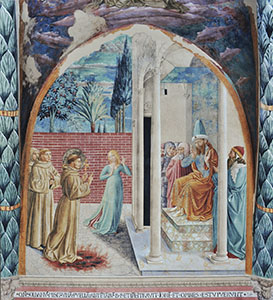
The Conversion of Sultan Melek-el-Kamel, Church of St. Francis, Montefalco.
Panel X
In this lunette, Benozzo narrates one of the miracles performed by Saint Francis during his life. While in Egypt, at the court of Sultan Melek-el-Kamel, he succeeded not only in converting the Eastern prince but also in evangelising a woman who had approached him with the intention of seducing him. With joy and simplicity, Saint Francis threw himself into the fire, inviting her to join him, in a demonstration of the protective power of God.
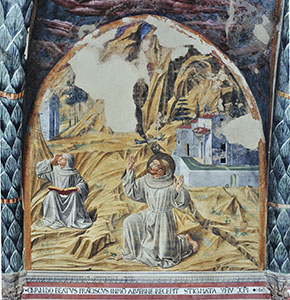
Stigmatisation of the Saint, Church of St. Francis, Montefalco.
Panel XI
The scene frescoed on the part of the lunette above the window is connected to the fresco painted on the right-hand wall. Rays emanate from the Crucifix, upheld by seraphim, and strike Saint Francis, kneeling with his hands raised. These are the five wounds of Christ that Saint Francis received on 14th September (the Feast of the Cross) 1224 in La Verna, Tuscany, a miracle that had never occurred before and which sealed the union between Saint Francis and Jesus Christ.
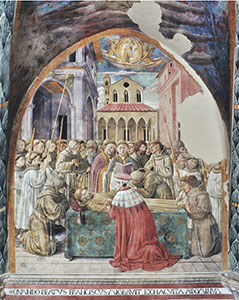
The Death and Assumption to Heaven of Saint Francis, Church of St. Francis, Montefalco.
Panel XII
The last episode in the cycle is the Death and Ascension of Saint Francis. In the foreground, we see the funeral of the Saint who is depicted lying on a bier. His wounds are displayed to the congregation while, behind him, his singing disciples bid him a final farewell. Above them, two angels carry Francis’ soul up to Heaven, encircled by a halo of light.
Serena Nocentini